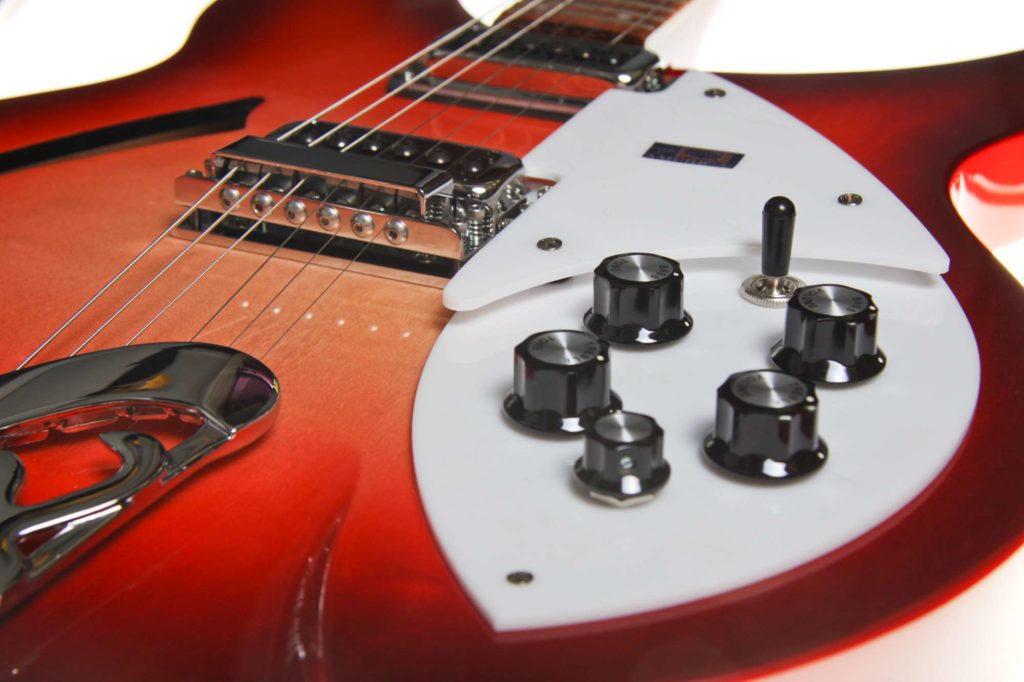10 Guitars You Need to Know #3: Rickenbacker
Author: Lucas Frost

Table of Contents
3. Hollow & Electric: The Rickenbacker 330
The resilience of the Rickenbacker 330 hollow-body electric guitar
During the 1950s, the popularity of the Fender Telecaster and the Gibson Les Paul made one thing clear: the solid body was here to stay. But it did not make hollow bodies redundant. One guitar in particular illustrates the resilience of the hollow-body electric guitar, known today as the semi-acoustic: the Rickenbacker 330. Its chiming, almost hypnotic clarity and famous “jangle” became an essential component of the British Invasion sound, appearing on The Beatles’ Hard Day’s Night and The Who’s My Generation. Even the world’s first psychedelic track, The Byrds’ Eight Miles High, based its groove on a Rickenbacker riff.
The Byrds’ “Turn, Turn, Turn”
Rickenbacker was the 1st Company to Specialize in Electric Instruments
Rickenbacker is central to the story of the guitar. It was the first company to specialize in electric instruments, and pioneered the mysteries of electro-magnetic music throughout the 1920s and 1930s. Noteworthy is the Hawaiian steel guitar known as the Frying Pan (due to its shape). The entire guitar was made out of a single block of aluminium and as a result suffered from tuning problems, as the whole instrument expanded under the heat of the stage lights. Rickenbacker also made a standard electric guitar, the Bakelie Model B which was introduced in 1935 – made out of the same material as bowling balls, it was heavy and reduced the feedback problems associated with hollow-body electrics. In 1958, Rickenbacker launched its most successful model, the 330. It’s a semi-acoustic.
The Main Difference is in the Tone
So what is the advantage of semi-acoustics? Obviously they are lighter and give you less back-pain after hours on stage. And the fact that they are hollow limits the luthier’s creativity, lending these guitars a more traditional, classical aesthetic. But of course the main difference is in the tone.
3 Advantages of Semi-Acoustics
- Lighter in weight (less back-pain)
- A more traditional, classic aesthetic
- Tone (main advantage)
Good Vibrations
When you strum the strings, they transmit their vibration via the bridge to the body; the body will vibrate along too and influence the vibration pattern of the strings. Certain harmonic overtones will be emphasized, others are diminished. A thin shell, such as in semi-acoustics, responds more directly to the strings vibration and has a greater impact on the overall frequency distribution. In addition, the air inside the hollow body will vibrate too, which creates interplay between the vibrating strings, body and air. So the final tone and sustain depends on other variables such as type and thickness of the wood, volume of air and f-holes.
Semi-acoustics come alive in all their responsive richness, warm, ringing overtones and delicious sustain
This greater “vibrational sensitivity” has another effect: feedback. Semi-acoustics are infamous for their tendency to feedback easily, and solid-bodies were pretty much invented to reduce this effect – guitarists would stuff foam into the body or tape over the f-holes to control their guitar’s screech. But in the hands of great guitarists, their feedback can be used to marvellous effects. With the right distance to the amp and perhaps a hint of overdrive, semi-acoustics will come alive in all their responsive richness, warm, ringing overtones and delicious sustain. The creative use of the semi-acoustics feedback “problem” led to great experimentation of textured soundscapes.
The Rickenbacker gave its shimmering sound to some of the most innovative and experimental bands ever
The Rickenbacker 330 is a great example, an instrument that has give its shimmering sound to some of
the most innovative and experimental bands ever. It is in reality only half-acoustic, with a cavity in only the upper side of the body and a futuristic f-hole to provide a little resonance. It shines in a band context, especially when paired up with a solid-body. This is how The Beatles, Oasis or The Smiths got that full, rich tapestry of sound that retains its sparkle without going muddy. Even AC/DC get their sound by combining hollow with solid body, albeit not with a Rickenbacker.
This is how The Beatles, Oasis or The Smiths got that full, rich tapestry of sound
Standout Features of the Rickenbacker 330
And of course, the 330 has plenty of other features that make it stand out. Rickenbacker seems to have
doubled many standard features. Most Rickenbackers have two truss-rods, side by side, which allow you to regulate the straightness of your neck more accurately (but it also increases neck weight). Some of the earlier 330s featured two output jacks, one for each pickup. This gave you the option of playing through multiple amps to create new sound palates, and gives you versatility with effect loops and a stereo stage sound. And the 330 has two tone and volume knobs (one per pickup) with the addition of a “blend” knob, which allows for a smooth tweaking of your tone – a bit like a single band EQ. The thick, flat-wound single-coil pickups accentuate clear, mid- to upper range tones with good definition. And if you want even more harmonic richness, there was the option of the 12-string 360 model [as seen in image].
Honorable Mentions: Other Semi-Acoustics
I would love to talk about some other semi-acoustics. To me they are such noble, elegant guitars. Gibson for instance has the ES-335 series which gives John Lee Hooker his stomping growl and Eric Clapton his thick butter, at least when he was playing with Cream. These guitars have a solid core to reduce feedback and increase sustain, but retain the warm, full tone of hollow-bodies. BB King (RIP) played a variation of this guitar called the Lucille, with different pickups and no f-holes, to reduce feedback even more. Or the Epiphone Casino, played by John Lennon and Noel Gallagher – it is entirely hollow, and has a slightly more ballsy sound than the ES-335. Or the Gretsch White Falcon, a high-end work of art billed as the “guitar of the future”. There is a lot of air space inside its large maple body, which contributes to a transparent, open and generous tone.
As you can see, there is a wide range of sounds and styles to choose from within the pantheon of semi-acoustics. There are many more that I could mention, all sounding unique and beautifully complex. And although it’s an unusual example of a semi-acoustic, Rickenbacker has a unique position in music history, and the 330s characteristic jangle, bright clear sound and bold aesthetic is a great reminder of that. So thank goodness that electricity did not kill the hollow bodies, otherwise our musical universe would be much poorer.
Now you know a little bit more about this guitar, we suggest you stay on our site and see what else you may need in your setup. We’ve reviewed lots of pedals, amps, apps, and more throughout the Uberchord blog. A few of our latest articles include how to transition smoothly between guitar chords, what is wimbo, and how to create interesting chord progressions.








Great article! Congratulations!!
I have a Rickenbacker 330 with hi gain pickups and i love it. In your opinion, for a clean sound( i’m a songwriter, no leads only strumming and arpeggios) what is the better semi hollow? Casino, 335 o Rick?
Thanks
REMEMBER uses Rickenbacker as does US The Edge also uses them. Great job Guys.
Thanks Randy.